weight BMW X5 3.0I 2005 E53 Owner's Manual
[x] Cancel search | Manufacturer: BMW, Model Year: 2005, Model line: X5 3.0I, Model: BMW X5 3.0I 2005 E53Pages: 200, PDF Size: 3.55 MB
Page 7 of 200
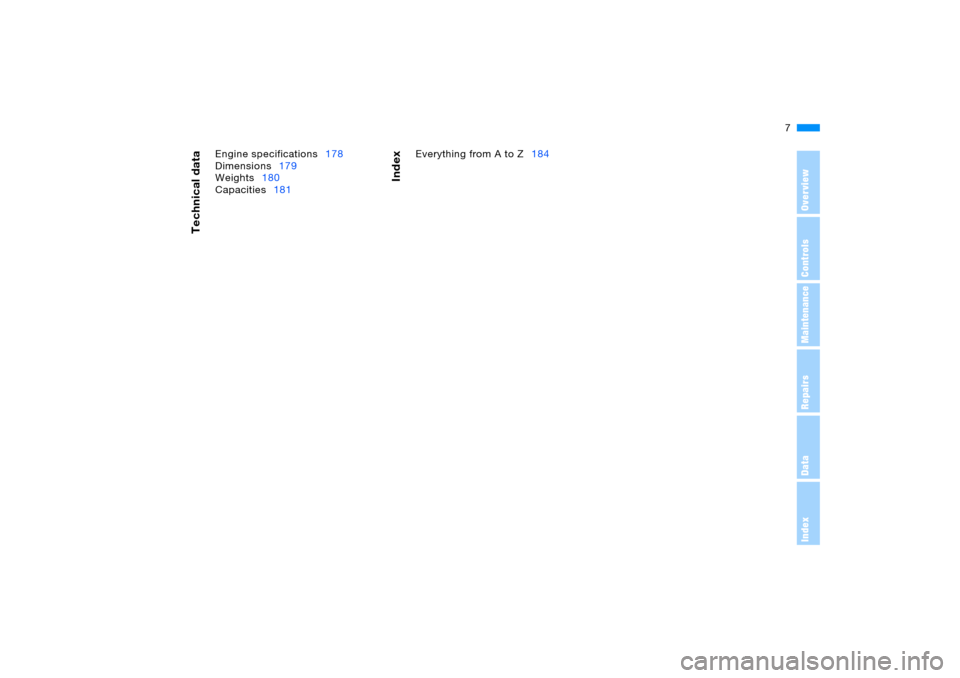
7n
OverviewControlsMaintenanceRepairsDataIndex
Technical data
Index
Engine specifications178
Dimensions179
Weights180
Capacities181Everything from A to Z184
Notes
Page 26 of 200
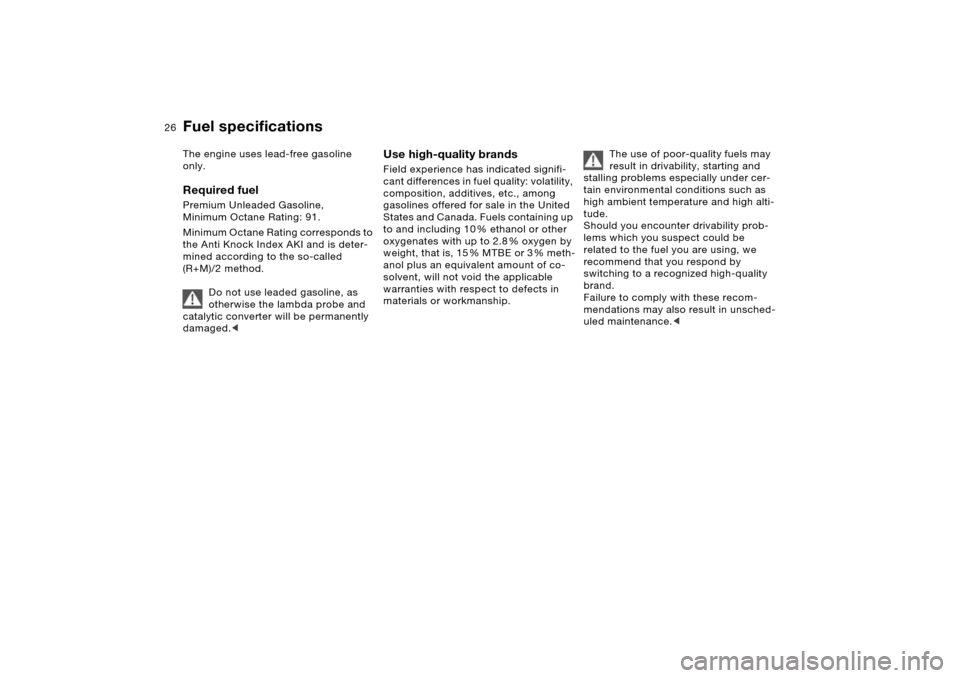
26n
Fuel specifications The engine uses lead-free gasoline
only.Required fuelPremium Unleaded Gasoline,
Minimum Octane Rating: 91.
Minimum Octane Rating corresponds to
the Anti Knock Index AKI and is deter-
mined according to the so-called
(R+M)/2 method.
Do not use leaded gasoline, as
otherwise the lambda probe and
catalytic converter will be permanently
damaged.<
Use high-quality brandsField experience has indicated signifi-
cant differences in fuel quality: volatility,
composition, additives, etc., among
gasolines offered for sale in the United
States and Canada. Fuels containing up
to and including 10 % ethanol or other
oxygenates with up to 2.8 % oxygen by
weight, that is, 15 % MTBE or 3 % meth-
anol plus an equivalent amount of co-
solvent, will not void the applicable
warranties with respect to defects in
materials or workmanship.The use of poor-quality fuels may
result in drivability, starting and
stalling problems especially under cer-
tain environmental conditions such as
high ambient temperature and high alti-
tude.
Should you encounter drivability prob-
lems which you suspect could be
related to the fuel you are using, we
recommend that you respond by
switching to a recognized high-quality
brand.
Failure to comply with these recom-
mendations may also result in unsched-
uled maintenance.<
Page 45 of 200
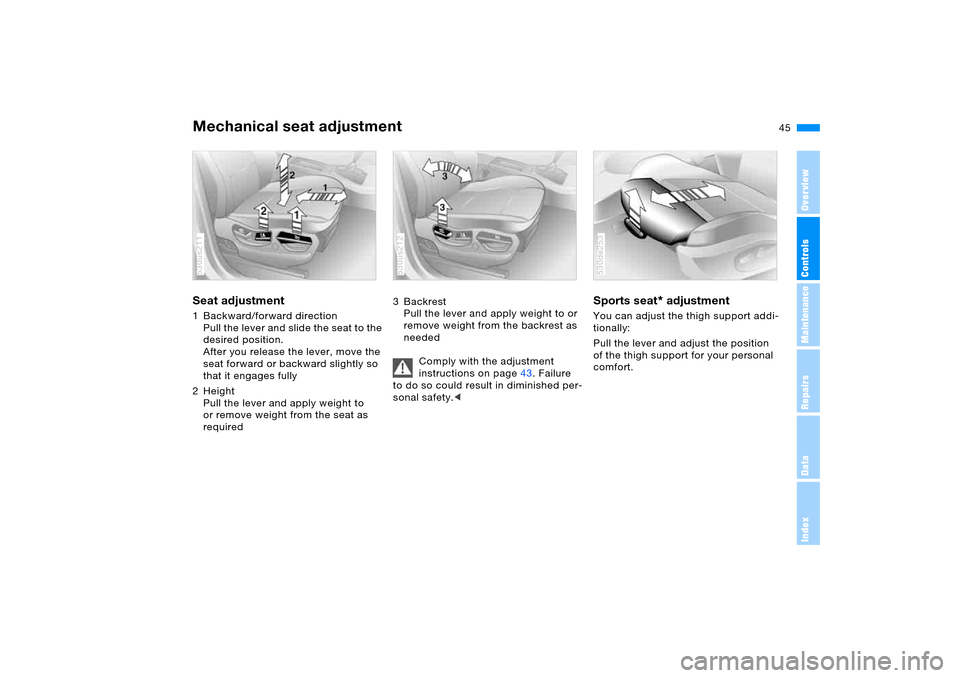
45n
OverviewControlsMaintenanceRepairsDataIndex
Mechanical seat adjustment Seat adjustment 1 Backward/forward direction
Pull the lever and slide the seat to the
desired position.
After you release the lever, move the
seat forward or backward slightly so
that it engages fully
2Height
Pull the lever and apply weight to
or remove weight from the seat as
required 530us211
3Backrest
Pull the lever and apply weight to or
remove weight from the backrest as
needed
Comply with the adjustment
instructions on page43. Failure
to do so could result in diminished per-
sonal safety.< 530us212
Sports seat
* adjustment
You can adjust the thigh support addi-
tionally:
Pull the lever and adjust the position
of the thigh support for your personal
comfort. 530de253
Page 59 of 200
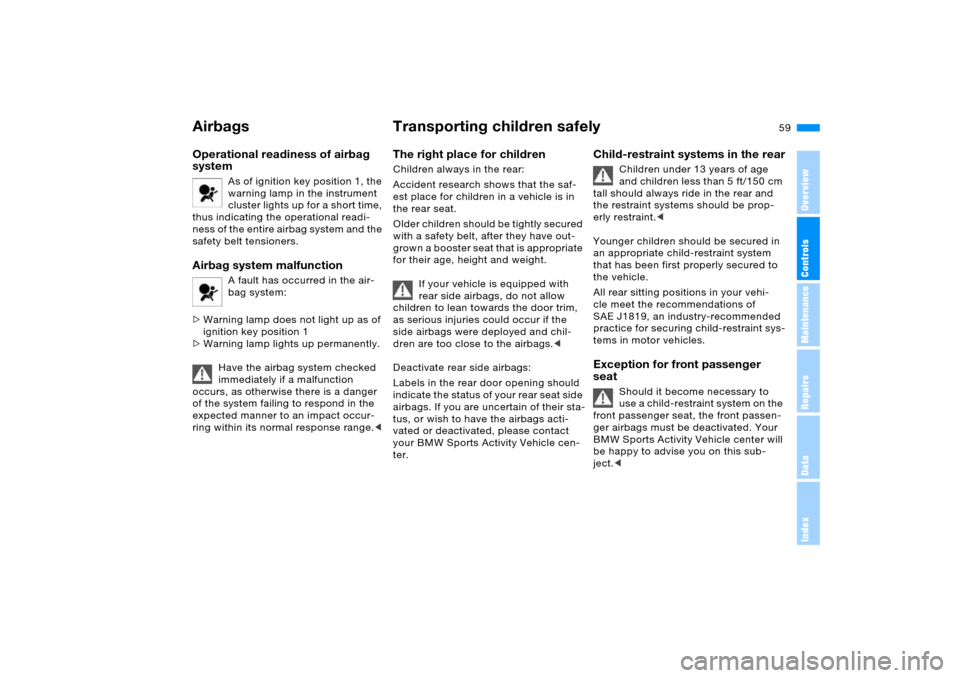
59n
OverviewControlsMaintenanceRepairsDataIndex
Airbags Transporting children safely Operational readiness of airbag
system
As of ignition key position 1, the
warning lamp in the instrument
cluster lights up for a short time,
thus indicating the operational readi-
ness of the entire airbag system and the
safety belt tensioners.
Airbag system malfunction
A fault has occurred in the air-
bag system:
>Warning lamp does not light up as of
ignition key position 1
>Warning lamp lights up permanently.
Have the airbag system checked
immediately if a malfunction
occurs, as otherwise there is a danger
of the system failing to respond in the
expected manner to an impact occur-
ring within its normal response range.<
The right place for children Children always in the rear:
Accident research shows that the saf-
est place for children in a vehicle is in
the rear seat.
Older children should be tightly secured
with a safety belt, after they have out-
grown a booster seat that is appropriate
for their age, height and weight.
If your vehicle is equipped with
rear side airbags, do not allow
children to lean towards the door trim,
as serious injuries could occur if the
side airbags were deployed and chil-
dren are too close to the airbags.<
Deactivate rear side airbags:
Labels in the rear door opening should
indicate the status of your rear seat side
airbags. If you are uncertain of their sta-
tus, or wish to have the airbags acti-
vated or deactivated, please contact
your BMW Sports Activity Vehicle cen-
ter.
Child-restraint systems in the rear
Children under 13 years of age
and children less than 5 ft/150 cm
tall should always ride in the rear and
the restraint systems should be prop-
erly restraint.<
Younger children should be secured in
an appropriate child-restraint system
that has been first properly secured to
the vehicle.
All rear sitting positions in your vehi-
cle meet the recommendations of
SAE J1819, an industry-recommended
practice for securing child-restraint sys-
tems in motor vehicles.
Exception for front passenger
seat
Should it become necessary to
use a child-restraint system on the
front passenger seat, the front passen-
ger airbags must be deactivated. Your
BMW Sports Activity Vehicle center will
be happy to advise you on this sub-
ject.<
Page 131 of 200
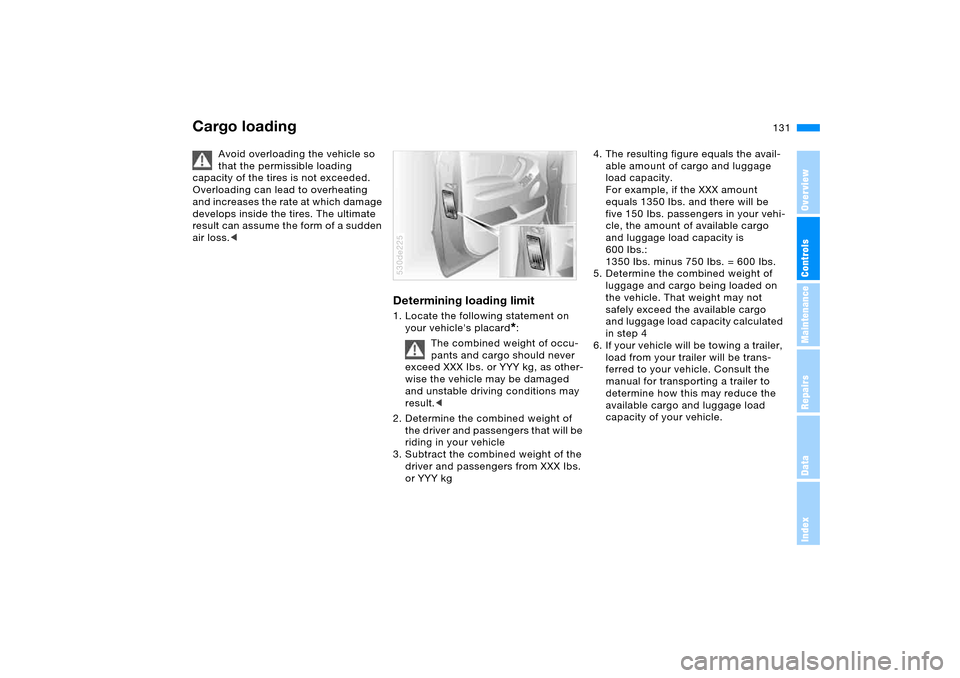
131n
OverviewControlsMaintenanceRepairsDataIndex
Cargo loading
Avoid overloading the vehicle so
that the permissible loading
capacity of the tires is not exceeded.
Overloading can lead to overheating
and increases the rate at which damage
develops inside the tires. The ultimate
result can assume the form of a sudden
air loss.<
Determining loading limit1. Locate the following statement on
your vehicle's placard
*:
The combined weight of occu-
pants and cargo should never
exceed XXX Ibs. or YYY kg, as other-
wise the vehicle may be damaged
and unstable driving conditions may
result.<
2. Determine the combined weight of
the driver and passengers that will be
riding in your vehicle
3. Subtract the combined weight of the
driver and passengers from XXX Ibs.
or YYY kg
530de225
4. The resulting figure equals the avail-
able amount of cargo and luggage
load capacity.
For example, if the XXX amount
equals 1350 Ibs. and there will be
five 150 Ibs. passengers in your vehi-
cle, the amount of available cargo
and luggage load capacity is
600 Ibs.:
1350 Ibs. minus 750 Ibs. = 600 Ibs.
5. Determine the combined weight of
luggage and cargo being loaded on
the vehicle. That weight may not
safely exceed the available cargo
and luggage load capacity calculated
in step 4
6. If your vehicle will be towing a trailer,
load from your trailer will be trans-
ferred to your vehicle. Consult the
manual for transporting a trailer to
determine how this may reduce the
available cargo and luggage load
capacity of your vehicle.
Page 132 of 200
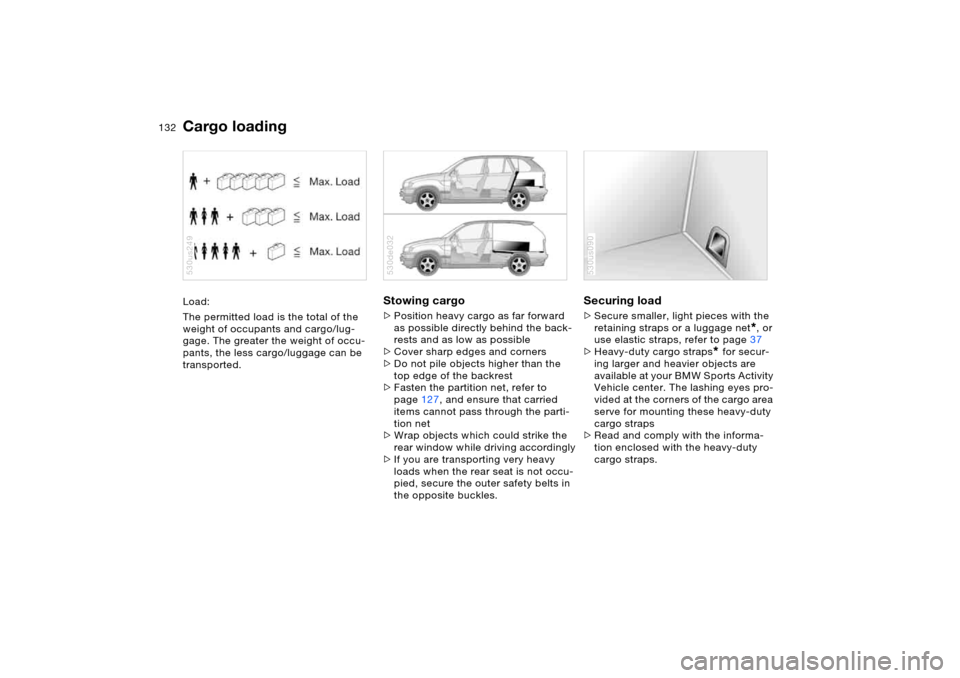
132n
Cargo loadingLoad:
The permitted load is the total of the
weight of occupants and cargo/lug-
gage. The greater the weight of occu-
pants, the less cargo/luggage can be
transported.530us249
Stowing cargo >Position heavy cargo as far forward
as possible directly behind the back-
rests and as low as possible
>Cover sharp edges and corners
>Do not pile objects higher than the
top edge of the backrest
>Fasten the partition net, refer to
page127, and ensure that carried
items cannot pass through the parti-
tion net
>Wrap objects which could strike the
rear window while driving accordingly
>If you are transporting very heavy
loads when the rear seat is not occu-
pied, secure the outer safety belts in
the opposite buckles. 530de032
Securing load >Secure smaller, light pieces with the
retaining straps or a luggage net
*, or
use elastic straps, refer to page37
>Heavy-duty cargo straps
* for secur-
ing larger and heavier objects are
available at your BMW Sports Activity
Vehicle center. The lashing eyes pro-
vided at the corners of the cargo area
serve for mounting these heavy-duty
cargo straps
>Read and comply with the informa-
tion enclosed with the heavy-duty
cargo straps.
530us090
Page 133 of 200
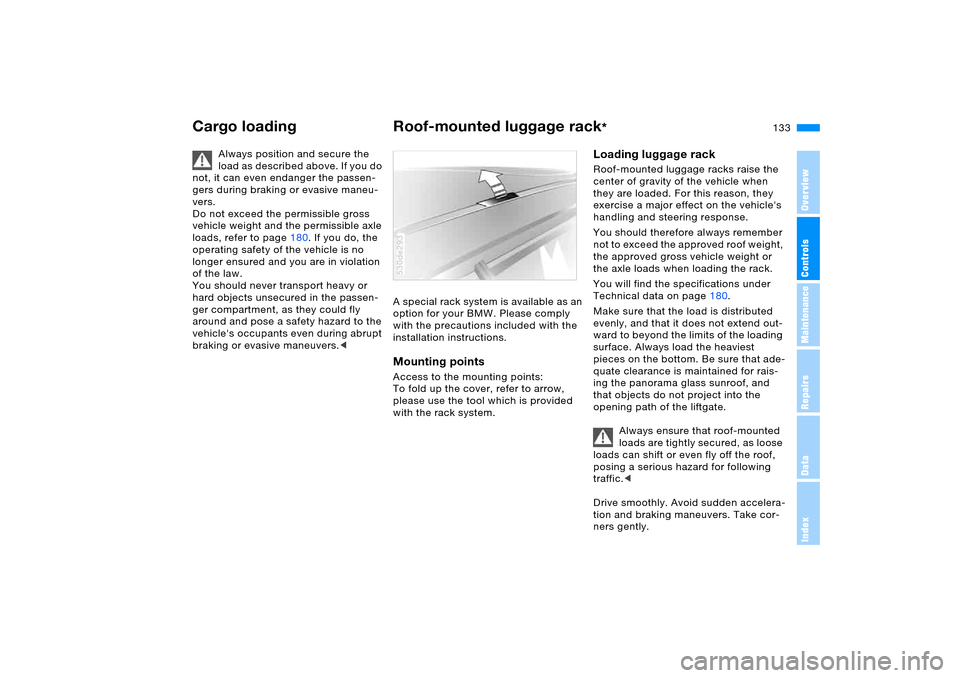
133n
OverviewControlsMaintenanceRepairsDataIndex
Cargo loading Roof-mounted luggage rack
*
Always position and secure the
load as described above. If you do
not, it can even endanger the passen-
gers during braking or evasive maneu-
vers.
Do not exceed the permissible gross
vehicle weight and the permissible axle
loads, refer to page180. If you do, the
operating safety of the vehicle is no
longer ensured and you are in violation
of the law.
You should never transport heavy or
hard objects unsecured in the passen-
ger compartment, as they could fly
around and pose a safety hazard to the
vehicle's occupants even during abrupt
braking or evasive maneuvers.<
A special rack system is available as an
option for your BMW. Please comply
with the precautions included with the
installation instructions.Mounting pointsAccess to the mounting points:
To fold up the cover, refer to arrow,
please use the tool which is provided
with the rack system.530de293
Loading luggage rackRoof-mounted luggage racks raise the
center of gravity of the vehicle when
they are loaded. For this reason, they
exercise a major effect on the vehicle's
handling and steering response.
You should therefore always remember
not to exceed the approved roof weight,
the approved gross vehicle weight or
the axle loads when loading the rack.
You will find the specifications under
Technical data on page180.
Make sure that the load is distributed
evenly, and that it does not extend out-
ward to beyond the limits of the loading
surface. Always load the heaviest
pieces on the bottom. Be sure that ade-
quate clearance is maintained for rais-
ing the panorama glass sunroof, and
that objects do not project into the
opening path of the liftgate.
Always ensure that roof-mounted
loads are tightly secured, as loose
loads can shift or even fly off the roof,
posing a serious hazard for following
traffic.<
Drive smoothly. Avoid sudden accelera-
tion and braking maneuvers. Take cor-
ners gently.
Page 142 of 200
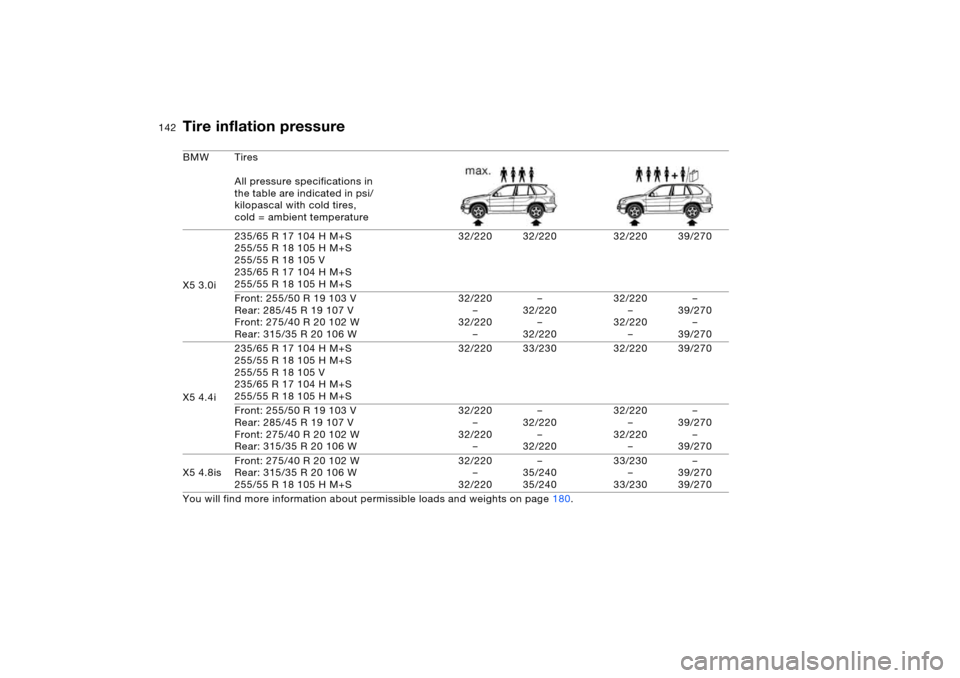
142n
Tire inflation pressureBMW Tires
All pressure specifications in
the table are indicated in psi/
kilopascal with cold tires,
cold = ambient temperature
X5 3.0i235/65 R 17 104 H M+S
255/55 R 18 105 H M+S
255/55 R 18 105 V
235/65 R 17 104 H M+S
255/55 R 18 105 H M+S32/220 32/220 32/220 39/270
Front: 255/50 R 19 103 V
Rear: 285/45 R 19 107 V
Front: 275/40 R 20 102 W
Rear: 315/35 R 20 106 W32/220
–
32/220
––
32/220
–
32/22032/220
–
32/220
––
39/270
–
39/270
X5 4.4i235/65 R 17 104 H M+S
255/55 R 18 105 H M+S
255/55 R 18 105 V
235/65 R 17 104 H M+S
255/55 R 18 105 H M+S32/220 33/230 32/220 39/270
Front: 255/50 R 19 103 V
Rear: 285/45 R 19 107 V
Front: 275/40 R 20 102 W
Rear: 315/35 R 20 106 W32/220
–
32/220
––
32/220
–
32/22032/220
–
32/220
––
39/270
–
39/270
X5 4.8isFront: 275/40 R 20 102 W
Rear: 315/35 R 20 106 W
255/55 R 18 105 H M+S32/220
–
32/220–
35/240
35/24033/230
–
33/230–
39/270
39/270
You will find more information about permissible loads and weights on page180.
Page 180 of 200
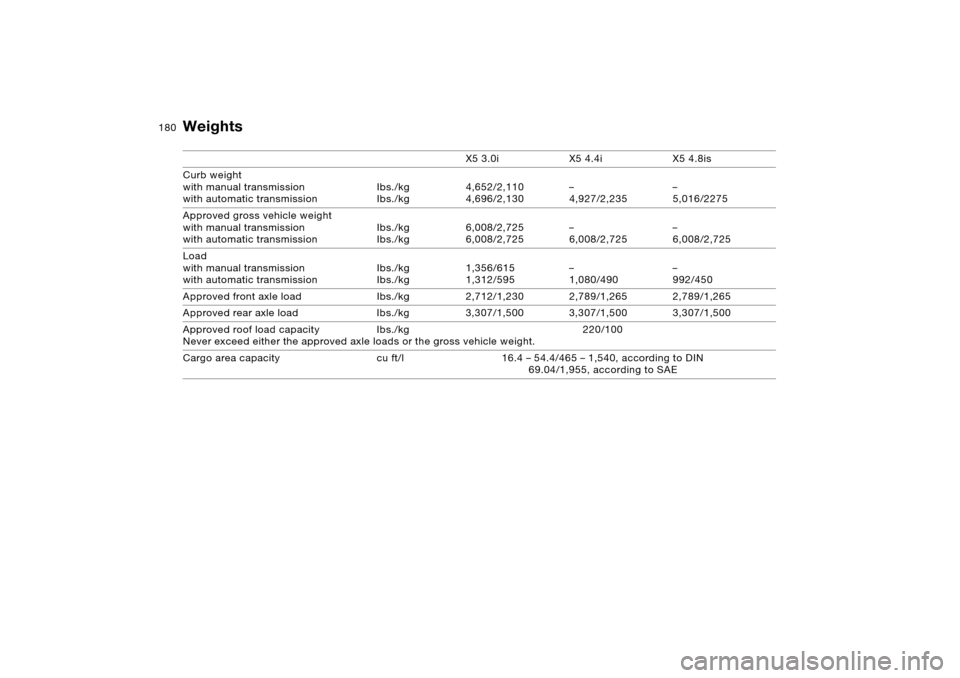
180n
Weights X5 3.0i X5 4.4i X5 4.8is
Curb weight
with manual transmission
with automatic transmission Ibs./kg
Ibs./kg4,652/2,110
4,696/2,130 –
4,927/2,235 –
5,016/2275
Approved gross vehicle weight
with manual transmission
with automatic transmission Ibs./kg
Ibs./kg6,008/2,725
6,008/2,725 –
6,008/2,725 –
6,008/2,725
Load
with manual transmission
with automatic transmissionIbs./kg
Ibs./kg1,356/615
1,312/595–
1,080/490–
992/450
Approved front axle load Ibs./kg 2,712/1,230 2,789/1,265 2,789/1,265
Approved rear axle load Ibs./kg 3,307/1,500 3,307/1,500 3,307/1,500
Approved roof load capacity Ibs./kg 220/100
Never exceed either the approved axle loads or the gross vehicle weight.
Cargo area capacity cu ft/l 16.4 – 54.4/465 – 1,540, according to DIN
69.04/1,955, according to SAE
Page 184 of 200
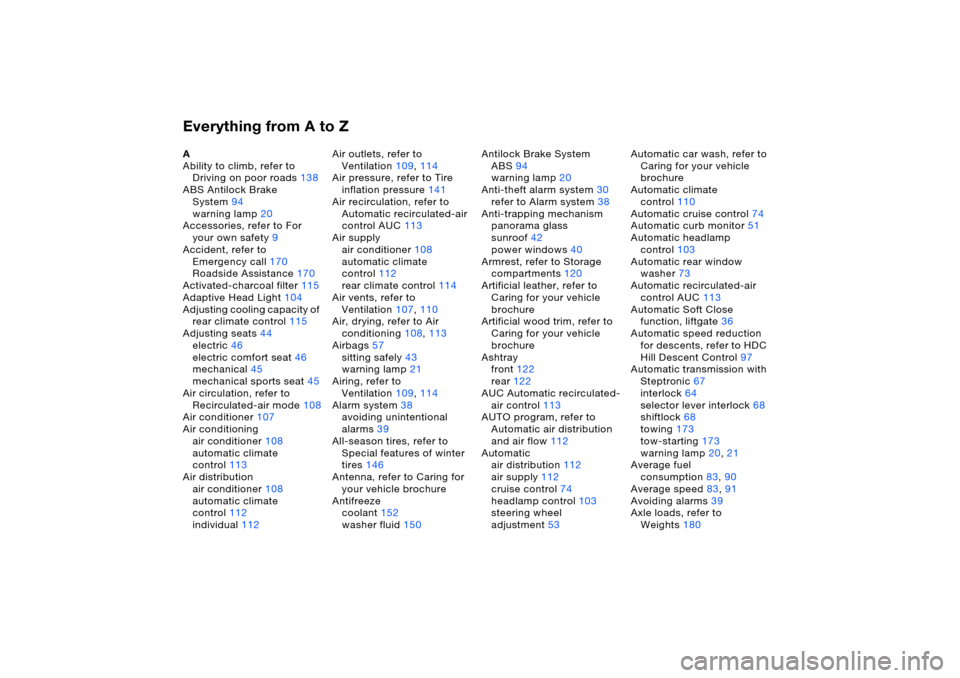
Everything from A to ZA
Ability to climb, refer to
Driving on poor roads138
ABS Antilock Brake
System94
warning lamp20
Accessories, refer to For
your own safety9
Accident, refer to
Emergency call170
Roadside Assistance170
Activated-charcoal filter115
Adaptive Head Light104
Adjusting cooling capacity of
rear climate control115
Adjusting seats44
electric46
electric comfort seat46
mechanical45
mechanical sports seat45
Air circulation, refer to
Recirculated-air mode108
Air conditioner107
Air conditioning
air conditioner108
automatic climate
control113
Air distribution
air conditioner108
automatic climate
control112
individual112Air outlets, refer to
Ventilation109,114
Air pressure, refer to Tire
inflation pressure141
Air recirculation, refer to
Automatic recirculated-air
control AUC113
Air supply
air conditioner108
automatic climate
control112
rear climate control114
Air vents, refer to
Ventilation107,110
Air, drying, refer to Air
conditioning108,113
Airbags57
sitting safely43
warning lamp21
Airing, refer to
Ventilation109,114
Alarm system38
avoiding unintentional
alarms39
All-season tires, refer to
Special features of winter
tires146
Antenna, refer to Caring for
your vehicle brochure
Antifreeze
coolant152
washer fluid150Antilock Brake System
ABS94
warning lamp20
Anti-theft alarm system30
refer to Alarm system38
Anti-trapping mechanism
panorama glass
sunroof42
power windows40
Armrest, refer to Storage
compartments120
Artificial leather, refer to
Caring for your vehicle
brochure
Artificial wood trim, refer to
Caring for your vehicle
brochure
Ashtray
front122
rear122
AUC Automatic recirculated-
air control113
AUTO program, refer to
Automatic air distribution
and air flow112
Automatic
air distribution112
air supply112
cruise control74
headlamp control103
steering wheel
adjustment53Automatic car wash, refer to
Caring for your vehicle
brochure
Automatic climate
control110
Automatic cruise control74
Automatic curb monitor51
Automatic headlamp
control103
Automatic rear window
washer73
Automatic recirculated-air
control AUC113
Automatic Soft Close
function, liftgate36
Automatic speed reduction
for descents, refer to HDC
Hill Descent Control97
Automatic transmission with
Steptronic67
interlock64
selector lever interlock68
shiftlock68
towing173
tow-starting173
warning lamp20,21
Average fuel
consumption83,90
Average speed83,91
Avoiding alarms39
Axle loads, refer to
Weights180